Lawrence T. Sullivan, the Lemuel Burrows, and U-boat 404
0 Comments Published by Jane on Monday, May 28, 2007 at 1:30 PM.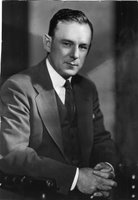 On March 14, 1942, in the Atlantic ocean off the coast of Atlantic City, New Jersey Otto Von Bulow, commander of the Nazi u-boat 404 spied the merchant marine vessel LEMUEL BURROWS. He gave the order to fire the torpedoes, confirmed the hit, and noted the name of the ship and tonnage destroyed in his log book. This was his third attack of the four ships he would sink during his March patrol along the northeast coast. A successful mission that would result in the award of the Knights Cross by Hitler on October 20th, 1942.
On March 14, 1942, in the Atlantic ocean off the coast of Atlantic City, New Jersey Otto Von Bulow, commander of the Nazi u-boat 404 spied the merchant marine vessel LEMUEL BURROWS. He gave the order to fire the torpedoes, confirmed the hit, and noted the name of the ship and tonnage destroyed in his log book. This was his third attack of the four ships he would sink during his March patrol along the northeast coast. A successful mission that would result in the award of the Knights Cross by Hitler on October 20th, 1942. For Otto Von Bulow and his crew onboard the U-404 the year 1942 was called "The Happy Time" because the American Admiralty had not yet organized their merchant marine into armed convoys. Nor had they instituted blackouts along the coastlines. With the bright lights of Atlantic City illuminating the silhouette of a lone freighter, hunting targets was easy. A friend of Von Bulow's relates this story the commander told him:
Otto told me that many of his ‘kills’ in the early part of the war were managed because the American Admiral did NOT believe that the British could teach him anything about the convoy system and protection.Lawrence T. Sullivan (pictured above) was serving as third-mate on the LEMUEL BURROWS that fateful March day in 1942. He was 42-years-old and had been sailing for most of his life. He graduated from the Massachusetts Nautical Training School (later to become Mass Maritime Academy) in 1921, obtained his pilot's license for the ports of Portland, Me., Boston, New York and Chesapeake bay and at 25 years-old was appointed captain of a steamship collier. He knew that coastline and he knew that ship (the LEMANUEL BURROWS was a collier, built in 1917), she was 7610 gross tons, and had 34 crew onboard. An old steamship carrying necessary freight up the coastline.
He also laughs as he tells me that he used to bring U404 close inshore off the coast of the USA and allow his crew on deck, to get some fresh air, watch the lights on shore and occasionally listen to music being wafted out to sea on the breeze.
Lawrence told his mother that it was only a matter of time before his ship was hit. He had seen the damage the uboats were inflicting on merchant marine vessels like his. He was sadly right and on March 14, 1942 twenty (Lawrence being one of the twenty) of that thirty-four member crew lost their lives when U404's torpedoes struck and sank the LEMUEL BURROWS.
Below is a 1942 German Newsreel on Uboat activity on the northeast US coast. While it does not show U404, nor the LEMANUEL BURROWS, it does give you an idea of how easy it was for the uboats to target freighters. This newsreel was filmed in Feb 1942
Labels: Sullivan
Page from the scrapbook - Lawrence T. Sullivan
3 Comments Published by Jane on Sunday, May 27, 2007 at 11:13 PM.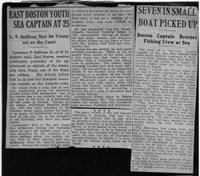 Pictured is a page from one of the old scrapbooks I have been scanning. Unfortunately, I don't know the source of the newspaper articles, nor the date.
Pictured is a page from one of the old scrapbooks I have been scanning. Unfortunately, I don't know the source of the newspaper articles, nor the date.EAST BOSTON YOUTH
SEA CAPTAIN AT 25
L. T. Sullivan May Be Youngest on the Coast
Lawrence T. Sullivan, 25, of 59 St. Andrew road, East Boston, received notification yesterday of his appointment as captain of the steamship John Tracy, one of the Tracy line colliers. His friends believe that he is now the youngest steamship captain on the Atlantic coast.
He comes from a long line of seamen, numbering among his ancestors several noted Irish navigators. One of his uncles was a sea captain, and was lost, with all the crew, in a shipwreck off the coast of Ireland. Except for his father, Patrolman Maurice Sullivan, who has been attached to the Hanover street police station for nearly 40 years, all Lawrence’s family are fond of the sea. He is the youngest of six brothers, and there are three sisters.
Lawrence’s love of the salt water was evidenced during his boyhood when he gave his mother many anxious moments by his cruising in a small sailboat about the harbor. He was born in East Boston, and was graduated from St. Mary’s parochial school. During the world war he tried to enlist in the naval air force, but was turned down because of his age. He then went to sea as a member of a tanker’s crew, and later worked on freighters.
He was graduated from the Massachusetts Nautical Training School in 1921, subsequently serving on freighters and other vessels, and obtaining his pilot’s license fro the ports of Portland, Me., Boston, New York and Chesapeake bay.
During his sea service, he had many exciting experiences. While on the oil tanker West Arrow of the Oriole Line a few years ago that vessel was in collision with a Cunarder and almost sunk in midocean. The tanker, badly damaged, reached port with great difficulty. He was serving on the steamship Brush of the Nawsco Line when she grounded on a sandbar off the Pacific coast. Wireless calls for aid were sent and life-savers’ craft came out and stood by until high water, when the Brush was floated. Later he received newspaper publicity by preventing a serious fire on a ship at the army base at South Boston.
Lawrence’s father came to Boston from Thomaston, Me. The steamship, which the young man will command, runs between Portland and Baltimore.
Labels: Sullivan
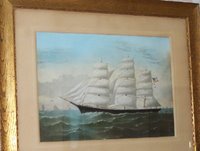 Here is the picture of the Alfred D. Snow - the ship that went down in 1888. My great-great uncle P.H. Sullivan was the first-mate on that ship. All hands were lost. The wreck made such an impression on the locals that a ballad was composed:
Here is the picture of the Alfred D. Snow - the ship that went down in 1888. My great-great uncle P.H. Sullivan was the first-mate on that ship. All hands were lost. The wreck made such an impression on the locals that a ballad was composed: Thanks again to Margaret McCrea and the Thomaston, ME Historical Society for all the great information!
The ALFRED D. SNOW (click on title for pdf of full lyrics)
by Michael O'Brien
Of ship-wrecks and dis-ast-ers we've read & seen a deal, But now the coast of Wex-ford must tell a dread-ful tale. On the
fourth day of Jan-u-ary the wind in a gale did blow, And four & twen-ty hands were lost on the "Al-fred D. Snow."
From the port of San Francisco she sailed across the main, Bound for the port of Liverpool, her cargo it was grain. On a
happy day she sailed away to cross the stormy foam: There's not a soul alive to-day to bring the tidings home.
If you'll attention pay to me, I won't detain you long, As I recall the mournful facts in this most feeling song. [END SNIPET]
Labels: Sullivan
P.H. Sullivan - another generation found
6 Comments Published by Jane on Wednesday, May 23, 2007 at 11:00 PM.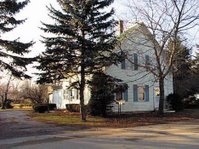 After posting the 1888 articles about the Alfred D. Snow shipwreck my Mother did a little research at the library and discovered that a Maine historian had recently presented a lecture on the subject - The Alfred D. Snow! She asked me to do some emailing to see if any information might be found and the following email message was received this evening:
After posting the 1888 articles about the Alfred D. Snow shipwreck my Mother did a little research at the library and discovered that a Maine historian had recently presented a lecture on the subject - The Alfred D. Snow! She asked me to do some emailing to see if any information might be found and the following email message was received this evening: Hi Jane!
You should have been in Thomaston, Maine last September when we presented a lecture on the Alfred D. Snow at the Thomaston Historical Society, which was repeated at the Owl's Head Transportation Museum this winter.
We were given a model of the Ship Alfred D. Snow, which had been crafted by a crewman aboard the vessel on a passage from Thomaston to CA. At that time Captain Willey and his family were aboard and the model was presented to the Captain's daughter, Lizzie, named in her honor.
This gift prompted a research into the vessel's past and the Thomaston men, who were part of her crew. We found the houses belonging to those men, who lost their lives in the tragedy. We didn't have much information on Patrick H. Sullivan's family. According to our genealogical sources, Patrick Sullivan came from county of Waterford, Ireland; m. Jane Brady of Thomaston on Aug 18, 1851. Patrick H. was the son of Patrick Sullivan.
Patrick's brother, Timothy, b. abt 1810 in Ireland and his wife Ellen were in Rockland, ME (neighboring town) at the same time. Timothy died suddenly on Feb 26, 1863, but left children.
I have attached a photo of Patrick Sullivan's house, which is on the same street of Captain Willey's home.
Sincerely,
Margaret McCrea
President, Thomaston Historical Society
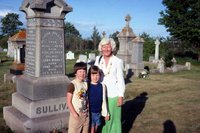 These exciting nuggets of information had me searching my scans of old slides and I came up with this image taken in 1976 or 1977 of my Mother (Suzanne Deedy) and my brother (Conal Deedy) and myself (Jane) in front of the Sullivan family gravestone (My Mother's mother was Helen Sullivan) in Thomaston, ME.
These exciting nuggets of information had me searching my scans of old slides and I came up with this image taken in 1976 or 1977 of my Mother (Suzanne Deedy) and my brother (Conal Deedy) and myself (Jane) in front of the Sullivan family gravestone (My Mother's mother was Helen Sullivan) in Thomaston, ME. 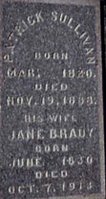 This close-up of the gravestone lists Patrick Sullivan (1820-1888) and his wife, Jane Brady (1830-1913). These are my great-great grandparents. The painting that started this whole research quest has been in the family for as long as my Mother could remember, but she had been told it was the ship of an Uncle who was lost at sea. It was only as we read the articles found on the back of the painting that more details emerged.
This close-up of the gravestone lists Patrick Sullivan (1820-1888) and his wife, Jane Brady (1830-1913). These are my great-great grandparents. The painting that started this whole research quest has been in the family for as long as my Mother could remember, but she had been told it was the ship of an Uncle who was lost at sea. It was only as we read the articles found on the back of the painting that more details emerged.Thanks to Margaret McCrea's information I can now confidently say Patrick Sullivan on the family gravestone is the Father of P.H. Sullivan, first-mate, who died in 1888 on the shipwreck of the Alfred D. Snow on the Irish coast.
The sea appears to have been both kind and cruel to my ancesters. My great-aunt Jane Austin Sullivan (daughter of Maurice Sullivan who was the brother of P.H. Sullivan) left behind some notes about her family history. They reveal that P.H. Sullivan's Father, Patrick, immigrated from Ireland with his Father and three brothers. He and two sons died of ships fever and are buried in Nova Scotia. G. Father Patrick Sullivan, after death of Father and two brothers made his way to Thomaston, ME. Stayed there working for Capt. Watts. The notes from my great-aunt continue with this: Gr. Mother Jane Brady born June 1830 died Oct. 7, 1913. She came from Ireland, June 1847 in the Brig. General Tailor commanded by Capt. Lilly of South Warren, her Father Maurice Brady her Mother Margaret Caraway of the Town of Sligo County Sligo Ireland.
In the notes Jane crossed out a paragraph. This is what I can make out of the scratched out notes:
Gr. Mother Jane Brady an orphan was going to be adopted by the Protestant side of the family the Cordways. The Bradys decided to send her to … The Brady’s in Maine Captain Lilly of South Warren Maine was looking for a nurse maid for his child on the voyage home. Jane came to Thomaston and lived with the Elliot’s. From these pieces of information a tale is starting to emerge. Patrick Sullivan, having survived the crossing from Ireland to Nova Scotia with his brother Timothy buried his Father and other two brothers and made his way to Thomaston, ME to work for Capt. Watts. In Thomaston, ME he met and married Jane Brady, who herself survived the crossing at age 17 - paying for her passage by working as a nursemaid for Capt. Lilly. Their son, P.H. Sullivan, later found work as a sailor for Captain Willey.
Patrick and Jane's younger son, Maurice, left Thomaston and moved down to Boston to work as a police officer. One of his sons (Lawrence Timothy Sullivan) became a Captain and loved the sea. He, like his uncle P.H. Sullivan, died at sea. His ship was torpedoed in World War II. More on that history later...
Labels: Sullivan
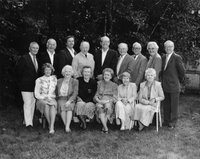 My Father found this photo taken years ago at a family gathering (maybe a wedding?) Pictured are cousins - all children of the McDonough girls.
My Father found this photo taken years ago at a family gathering (maybe a wedding?) Pictured are cousins - all children of the McDonough girls. My Father did his best to identify everyone below. As always you can click on the image to see larger.
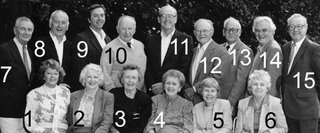
1) Dodie Burgess (daughter of Eva McDonough)
2) Nancy Fay (daughter of Ann McDonough)
3) Marion (O'Leary) Roosevelt (daughter of Mary McDonough O'Leary)
4) Evelyn P. McDonough-Garton (daughter of Patrick T. McDonough)
5) Mary Jane Kennedy Gaitings (daughter of Kate McDonough)
6) Peg Rafferty (daughter of Lou McCarthy)
7) Bill Burgess (son of Eva McDonough)
8) Ted Thompson (son of Agnes McDonough)
9) Tom Deedy (son of Grace McDonough)
10) Bill Fay (son of Ann McDonough)
11) Leslie Thompson (son of Agnes McDonough)
12) Tom Kennedy (son of Kate McDonough)
13) Jim Fay (son of Ann McDonough)
14) Jack Deedy (son of Grace McDonough)
15) Ed Deedy (son of Grace McDonough)
If I have made a mistake please correct me in the comments!
Labels: McDonough
 This old newspaper article was attached to the back of an old watercolor painting in my Mother's home. The painting depicts the ship Alfred D. Snow which went down with all hands off the coast of Ireland in 1888. The first mate, P.H. Sullivan, was a great-great-uncle on my Mother's side. Below are the text of two articles found behind the painting. The old news paper articles are in poor shape, some words are missing - I did the best I could to preserve the contents of the stories below:
This old newspaper article was attached to the back of an old watercolor painting in my Mother's home. The painting depicts the ship Alfred D. Snow which went down with all hands off the coast of Ireland in 1888. The first mate, P.H. Sullivan, was a great-great-uncle on my Mother's side. Below are the text of two articles found behind the painting. The old news paper articles are in poor shape, some words are missing - I did the best I could to preserve the contents of the stories below:ALL HANDS LOST
Wreck of a Thomaston Ship on the Irish Coast.
The Alfred D. Snow Goes Down with All on Board.
Capt. Wiley's Wife One of the Victims of the Wreck.
DUBLIN, Jan 5. - The vessel Alfred D. Snow was driven ashore and wrecked today, in Herryloch Bay, at Arthurstown, county Wexford. The crew were drowned. The bodies of the captain and three of the crew were recovered.
London, Jan. 5. - It is now known definitely that the vessel wrecked near Waterford, Ireland, was the American ship Alfred D. Snow, Capt. Wiley, which left San Francisco Aug. 31st, for Liverpool. The ship was lost in Herrylock Bay, off Arthurstown at the entrance to Waterford Harbor. There is no doubt that every member of the crew perished. The ship's papers have been recovered.
SAN FRANCISCO, Jan. 5 - The American ship Alfred D. Snow whose loss is reported from Waterford, Ireland, was one of the Nevada Bank's fleet of wheat ships. She departed for Liverpool, Aug. 3d last, having been cleared the day previous by William Dresback, the leader of the "bull" clique in the later wheat deal. The crew consisted of Capt. W.H. Wiley, first mate P.H. Sullivan, second mate John Child, and 26 seamen.
Capt. Wiley's wife accompanied him on the voyage. The cargo of wheat was valued at $95,000 and insured. The Alfred D. Snow was owned by T. W. Chapman & Co., of Thomaston, Me. She cost $115,000 and was fully insured in Eastern companies.
[The Alfred D. Snow was built in Thomaston in 1877, where she hails from. Her dimensions are as follows: Length, 232 feet; breadth, 42; depth, 21; and her gross tonnage 2075. -ED.]
Extract from Liverpool paper given by Capt. Hodgkins Jan. 1888.
Captain of a Station Life Boat Charged with Cowardice
Details of the Wreck of the Alfred D. Snow
Public Inquiry into the Matter to Be Made.
New York, Jan. 11, 1888. A special from Waterford Lt., to the Herald says the wreck of the American ship Alfred D. Snow of Maine can be seen at low water lying on its side on the shoal. Five bodies, including that of the captain, have been recovered as they washed up in the harbor. Among the crew, according to a list found in a memorandum book in the captain's pocket, were Capt. W. J. Willey, John Willey, son of the captain, Thomas McMahon, A.H. Slack, P.H. Sullivan, John Lermond and Robert Barter, all of Maine; P.J. Ledger of New York, George F. Dornes, F.W. Firham of Connecticut, John MacDougal of Vermont. John Johnson of Chicago, James Harrison of Massachusetts, Kellogg of Michigan and James Schoaer of New York.
At the opening of the inquest it appeared that the captain of the station life boat, on the morning of the wreck refused to put the boat out, on the ground that the weather was too rough, in which he was supported by a few of his crew, but the majority wished to proceed. In the port of Danmore, a short distance away, were some Manx fishing boats, whose crews insisted on taking on the life boat in spite of its captain by force, and assisted by the consenting members of the life boat's crew. They pulled ot the wreck while the storm was its fiercest, but the delays made them arrive too late to render any assistance, the crew of the Snow being one by one swept away by the waves, in the very sight of the succoring boat. The latter pulled around the wreck, but fruitlessly. The cowardly captin of the life boat is in danger of being lynched, while the Manx crew are being made heroes of. The body of Capt. Willey has been embalmed, and will be sent to Thomaston, Me.
Owing to the above serious allegations, the committee of the local branch of the National Life Boat Institution held a meeting yesterday to consider the advisability of holding a public inquary in the matter, which was decided on.
The funeral over the remains recovered was impressively held yesterday, and the whole town may be said to have mourned the sad fate of the strangers.
The body of Capt. Willey of Maine, who was drowned by the wreck of the ship Alfred D. Snow on the Irish coast, has been embalmed and placed on board the steamer City of ?? sailed from Queen ??
Interesting reuse of the ship in Ireland...
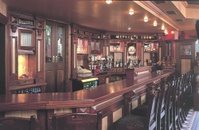 The fully air conditioned Alfred D. Snow Bar at the Ocean Hotel is named after the ship Alfred D. Snow which floundered off our coast in 1888 and whose timbers were used in the original construction of the pub in 1890 where they still remain today. The walls of the bar abound with writings on the history of that ship.
The fully air conditioned Alfred D. Snow Bar at the Ocean Hotel is named after the ship Alfred D. Snow which floundered off our coast in 1888 and whose timbers were used in the original construction of the pub in 1890 where they still remain today. The walls of the bar abound with writings on the history of that ship.Labels: Sullivan
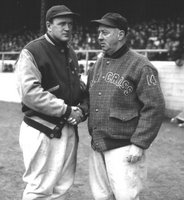 Dad was visiting Fenway Park yesterday to attend the Red Sox game. A fundraising booth had been set-up and the Boston Public Library was selling prints of old Red Sox photos found in the archives. He was amazed to see this image of his uncle Jack Barry shaking Joe Cronin's hand in an undated Fenway Park photo.
Dad was visiting Fenway Park yesterday to attend the Red Sox game. A fundraising booth had been set-up and the Boston Public Library was selling prints of old Red Sox photos found in the archives. He was amazed to see this image of his uncle Jack Barry shaking Joe Cronin's hand in an undated Fenway Park photo. The person selling the photos said this picture was one of its most popular. Lots of Joe Cronin fans and Holy Cross alumni were the main purchasers.
Labels: Jack_Barry
The Man Who Made The Red Sox Team
0 Comments Published by Jane on Thursday, May 10, 2007 at 11:29 PM.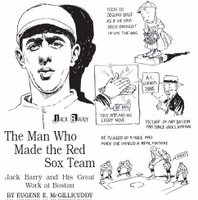 We are counting down to the July 2 - 4th induction of Jack Barry to the College Baseball Hall of Fame in Lubbock, Texas. Here is a 1915 The Baseball Magazine article about Jack Barry.
We are counting down to the July 2 - 4th induction of Jack Barry to the College Baseball Hall of Fame in Lubbock, Texas. Here is a 1915 The Baseball Magazine article about Jack Barry.The Man Who Made The Red Sox Team
Jack Barry and His Great Work at Boston
by Eugene McGillicuddy
WELL the White Sox got the famous Eddie Collins, and the Red Sox got Barry. You said it, boy, the Red Sox got Barry!
When the old Roman purchased Eddie Collins at the enormous price of $50,000, all fandom gasped, and then agreed the White Sox had made a ten strike. If there was one ball player in the business who would make a team pennant contenders, Eddie Collins was the man, the star of the famous Mack machine, and one of the game’s greatest hitters and base runners.
The pale-hosed crew lived up to expectations, with Collins at the helm, and jumped to the lead from the start, showing the way to all comers.
Then the news bobbed out that Connie Mack intended to rebuild his great ball club, and that Jack Barry and others were on the market. While Barry was not considered nearly as valuable in all around ability as Collins, still his clever fielding and ability to come through in a pinch made him a good investment for any club. Chicago wanted him, so did New York, but Jack being a Worcester boy, preferred Boston, and Lannin once more opened his purse strings for a high-grade player.
Speculation was rife among the fans as to what position Barry would play, for in Scott the Red Sox had one of the game’s greatest and most promising short fielders, with Janvrin, another young star, pressing him hard. On the other side of the bag Heine Wagner, the veteran shortstop, was endeavoring to do a come-back stunt after a year’s absence and was doing well except for a little slowness in the field.
When Barry was suggested as a second baseman, many claimed it couldn’t be done and pointed to the fact that Jack had started out as a keystone sacker with the A’s and failed to make good. Nevertheless, second was the position assigned him, and he took up the job against Washington on the 5th of July.
Talk about Collins rounding out the White Sox and making them a real winning machine, why Boston fans will tell you that trick didn’t fit for a minute with the way Barry made the Red Sox. From the day he pulled on his glove in a Boston uniform, the team started to come, the old slowness in handling the ball around second base changed to lightning double plays old-timers say a pennant winning club must be strong in this department), and the question, ”What can be the matter with the Red Sox ?” changed to “Wonder who the Sox will meet in the big series this fall?” Ask any loyal rooter and he will tell you
that Jack Holy Cross Barry is the big reason.
When you are talking about keystone kings, don’t overlook this bird either. He’s working like a charm with Everett Scott and Hal Janvrin, and making the superhuman stops and catches that made him famous as the “Flying Octopus.” Also it would take a chapter to recount the games he has won with his timely stick work.
And so, although the White Sox got Collins and eventually Murphy, Jackson and Leibold, there is a whole chapter in that one little line, “THE RED SOX GOT BARRY —THE MAN WHO MADE THE TEAM.”
Labels: Jack_Barry
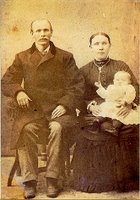 Once again Mary Kennedy Dean has contributed a gem of a picture. This time it is an 1880 family portrait of a young McDonough family. Mary reports that this picture was found in MaryJane's effects. Having seen the much larger and later McDonough family portrait - it is nice to see that when they had only one child the young couple look much more relaxed!
Once again Mary Kennedy Dean has contributed a gem of a picture. This time it is an 1880 family portrait of a young McDonough family. Mary reports that this picture was found in MaryJane's effects. Having seen the much larger and later McDonough family portrait - it is nice to see that when they had only one child the young couple look much more relaxed!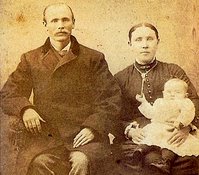 Pictured are Thomas McDonough (born in Sligo, Ireland 1853) and his wife Mary Morely Loftus McDonough (born York, England 1852) with their daughter Mary McDonough (born Worcester, Massachusetts 1879).
Pictured are Thomas McDonough (born in Sligo, Ireland 1853) and his wife Mary Morely Loftus McDonough (born York, England 1852) with their daughter Mary McDonough (born Worcester, Massachusetts 1879). Thanks again Mary for the great contribution!
Labels: McDonough
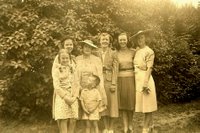 Mary Kennedy Dean has once again been busy looking in old photo albums and has contributed another great family photo. You can click on the picture to see it larger. Hard to believe (for me) but that little boy pictured is my Dad!
Mary Kennedy Dean has once again been busy looking in old photo albums and has contributed another great family photo. You can click on the picture to see it larger. Hard to believe (for me) but that little boy pictured is my Dad!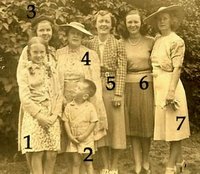 Here are the names provided by Mary (my edits are in italics):
Here are the names provided by Mary (my edits are in italics):1. Marie McCarthy
2. Thomas Reed Deedy
3. MaryJane Kennedy
4. Aunt Ann (Ann McDonough Fay)
5. Marion O'Leary (daughter of Mary McDonough O'Leary)
6. Peggy (Rafferty?)
7. Aunt Grace (Grace McDonough Deedy)
Labels: McDonough

